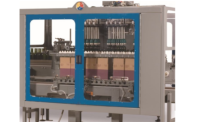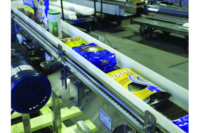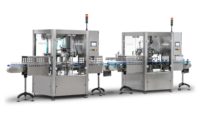As digital printing capabilities continue to improve for flexible packaging, the industry is moving into spaces where only flexographic or rotogravure printing have been the standard. The digitally printed packaging market is expected to grow nearly 13% each year exceeding $22 billion by next year, according to Smithers, a global testing, consulting and compliance firm.
This is an exciting shift in the industry: The market is expanding quickly for smaller companies that now have greater abilities to offer attractive packaging that resonates with consumers and communicates vital brand messaging. It also allows brands of any size to take advantage of the shorter-run opportunities generated by digital printing, creating more pathways for special promotions, products and other needs.
Flexible packaging converters need to be ready for these short-run requests. This is achieved by having machinery optimized for quicker changeovers by working closely with manufacturing partners. These partnerships are the key to gaining the expertise necessary to utilize new technologies to their benefit, increasing efficiencies and decreasing machine downtime.
The Growth of Digital Printing
Digital printing providers are driven by the success of flexible packaging companies such as ePac, a company formed in 2015 with a focus on catering to small- and medium-size businesses working with niche products. Such providers are filling a need for smaller run volumes that packaging companies utilizing more traditional printing techniques couldn’t provide at a reasonable cost.
Being able to develop custom graphics that can change at the click of a button has transformed the industry. Additionally, these packages can be designed and easily redesigned to target regional or national markets, thus creating improved flexibility and reach that may not have been previously available. Digital printing makes it much easier to change SKUs without going through time-consuming and expensive cylinder sleeve changeovers.
Advantages Created by Short-run Printing
The switch to digital is a culture shift in the industry as well: Converters are accustomed to running the same job on a machine, possibly for weeks at a time. In the past, a minimum of a 50,000-pouch run on a traditional printer may have been required for cost benefits, but now it’s possible to run 500 or 1,000 pouches and still provide financial value. While companies with large runs still benefit from flexo and roto printing, digital has created a new path for companies that need shorter runs.
This short-run capability makes it easier for specialized food producers such as confectionaries, specialty pet food producers, or even some of the new cannabis product makers, to move to a custom-printed package for the same cost as the bigger CPGs. Plus, it creates an opportunity for improved branding by making it more affordable for smaller companies to design packaging that reflects a company’s particular style and better showcases its products.
Companies like this may only need a quantity of 5,000 packages, and now instead of using plain stock pouches with a sticker label, they can have packaging that’s bright, colorful and draws consumers’ attention. Similarly, companies that are focused on printing labels are seeing the potential of flexible packaging as an area with future growth opportunity.
Creating a Better Changeover Rate
This trend toward digital printing is forcing pouch machine manufacturers to become more automated and efficient. As they look to reduce scrap and downtime, they’re also looking at how to decrease changeover times, knowing that the machine isn’t profitable when it isn’t making good product.
While changeovers from one color or graphic to the next (SKU to SKU) for digitally printed material doesn’t take much time, there’s still time taken to switch from one pouch size to another. The quicker this can happen, the quicker the profitable production run phase can resume.
Making Machines More Efficient
Pouch machine manufacturers have created modifications to better accommodate these shorter runs by adjusting the equipment to create better, quicker changeovers. Recipe-saving features accompanied by positioning assist systems, for example, can save job settings on the machine HMI and essentially give the operator a guide for where everything needs to be physically positioned. This kind of repeatability is key to ensuring quality seals and pouches on every job.
Tooling modifications have been a big step forward as well. Being able to adjust tools without removing them from the machine has proved to save time and be a much safer process. If tools do need to be removed, new “quick-release” versions of these can allow for more efficiencies by changing the required action from threaded rod removal to a simple lever instead. Converters have also attempted to standardize their pouch sizes and formats to help lessen the number of actions needed during a typical changeover.
Some manufacturers have even tried to condense the size of their machines to create efficiencies but have also introduced new challenges. Actions such as zipper crushing, which requires high amounts of heat transfer, are more difficult to accommodate with a more compact machine. Speed is certainly sacrificed since often much longer seal dwell times are required to obtain pouches with high seal integrity.
The success of ePac’s model has created a rush for many brands and startups to enter the digital printing and converting space. This is an exciting time of change for both printers and equipment manufacturers alike. These new relationships create important moments to focus on machine operation and maintenance since, many times, these machines are the first to enter a new facility. It also creates an increased demand on manufacturers to offer a more hand-in-hand approach to service and support to help guide these new ventures and help them succeed.
With these changes comes a great opportunity for innovation and partnership as we work together to decrease changeover time and create superior efficiency in the process.





